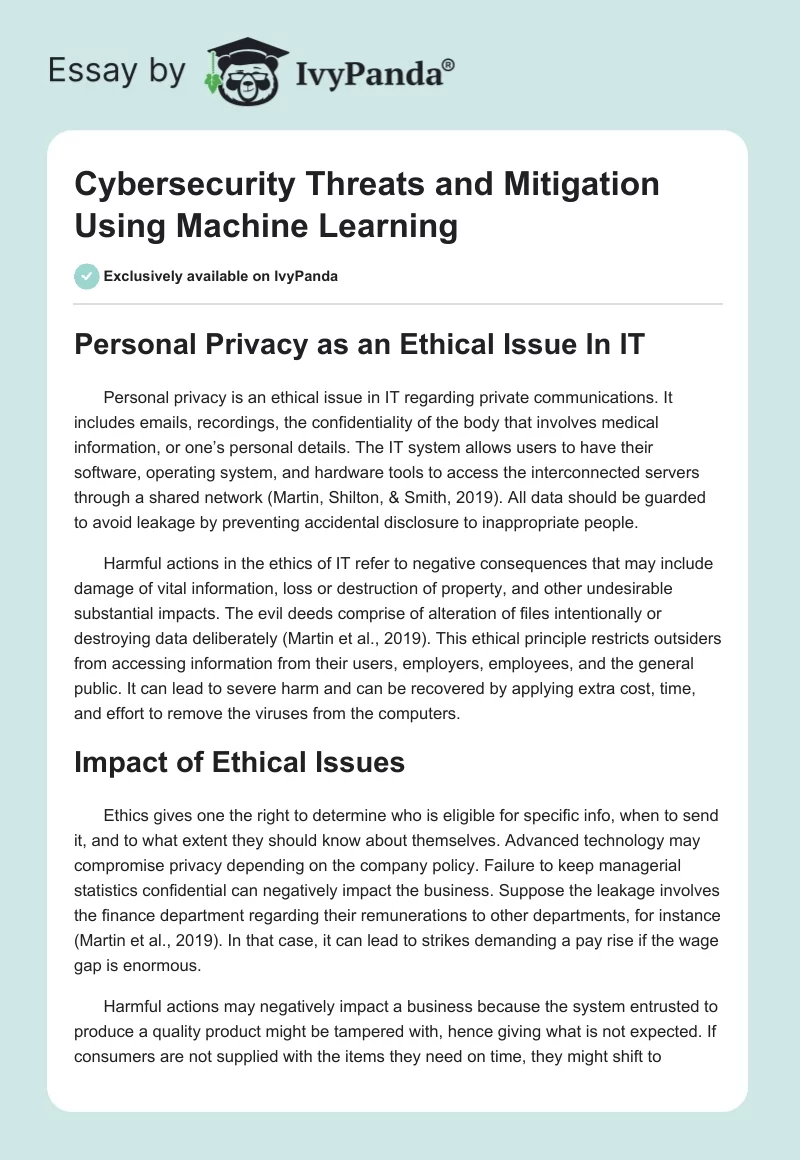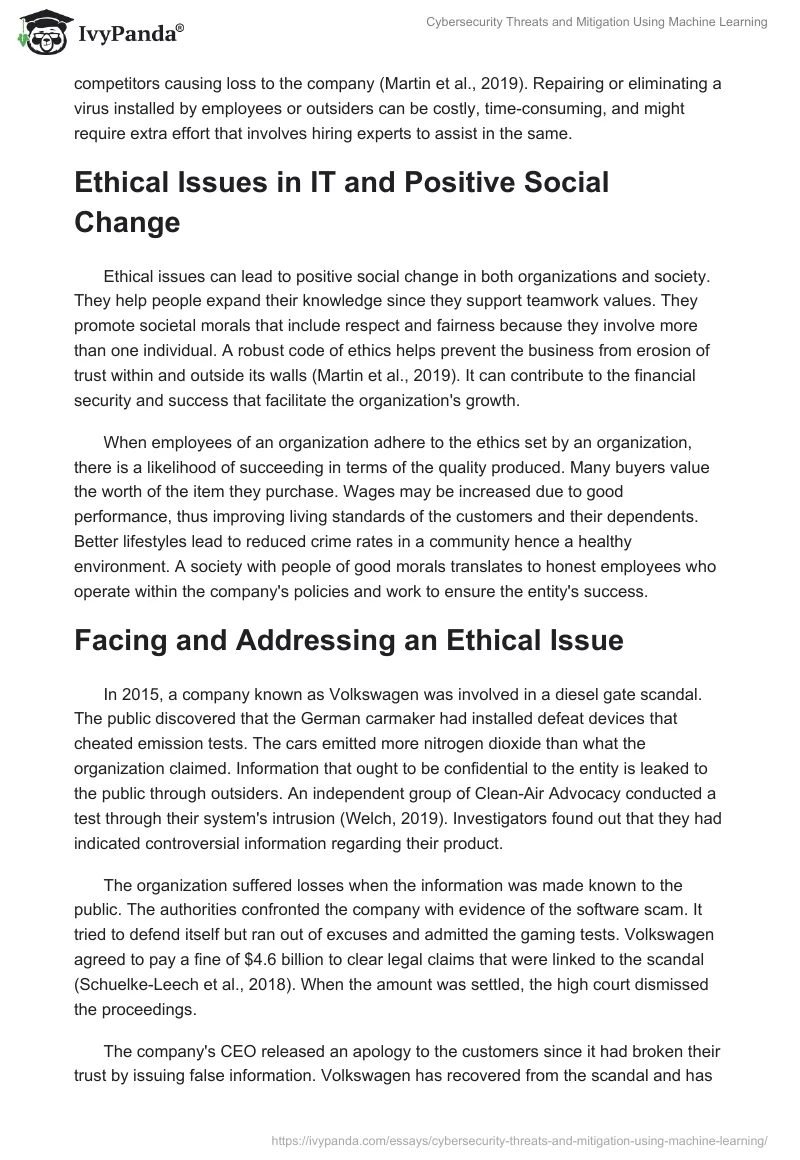Personal Privacy as an Ethical Issue In IT
Personal privacy is an ethical issue in IT regarding private communications. It includes emails, recordings, the confidentiality of the body that involves medical information, or one’s personal details. The IT system allows users to have their software, operating system, and hardware tools to access the interconnected servers through a shared network (Martin, Shilton, & Smith, 2019). All data should be guarded to avoid leakage by preventing accidental disclosure to inappropriate people.
Harmful actions in the ethics of IT refer to negative consequences that may include damage of vital information, loss or destruction of property, and other undesirable substantial impacts. The evil deeds comprise of alteration of files intentionally or destroying data deliberately (Martin et al., 2019). This ethical principle restricts outsiders from accessing information from their users, employers, employees, and the general public. It can lead to severe harm and can be recovered by applying extra cost, time, and effort to remove the viruses from the computers.
Impact of Ethical Issues
Ethics gives one the right to determine who is eligible for specific info, when to send it, and to what extent they should know about themselves. Advanced technology may compromise privacy depending on the company policy. Failure to keep managerial statistics confidential can negatively impact the business. Suppose the leakage involves the finance department regarding their remunerations to other departments, for instance (Martin et al., 2019). In that case, it can lead to strikes demanding a pay rise if the wage gap is enormous.
Harmful actions may negatively impact a business because the system entrusted to produce a quality product might be tampered with, hence giving what is not expected. If consumers are not supplied with the items they need on time, they might shift to competitors causing loss to the company (Martin et al., 2019). Repairing or eliminating a virus installed by employees or outsiders can be costly, time-consuming, and might require extra effort that involves hiring experts to assist in the same.
Ethical Issues in IT and Positive Social Change
Ethical issues can lead to positive social change in both organizations and society. They help people expand their knowledge since they support teamwork values. They promote societal morals that include respect and fairness because they involve more than one individual. A robust code of ethics helps prevent the business from erosion of trust within and outside its walls (Martin et al., 2019). It can contribute to the financial security and success that facilitate the organization’s growth.
When employees of an organization adhere to the ethics set by an organization, there is a likelihood of succeeding in terms of the quality produced. Many buyers value the worth of the item they purchase. Wages may be increased due to good performance, thus improving living standards of the customers and their dependents. Better lifestyles lead to reduced crime rates in a community hence a healthy environment. A society with people of good morals translates to honest employees who operate within the company’s policies and work to ensure the entity’s success.
Facing and Addressing an Ethical Issue
In 2015, a company known as Volkswagen was involved in a diesel gate scandal. The public discovered that the German carmaker had installed defeat devices that cheated emission tests. The cars emitted more nitrogen dioxide than what the organization claimed. Information that ought to be confidential to the entity is leaked to the public through outsiders. An independent group of Clean-Air Advocacy conducted a test through their system’s intrusion (Welch, 2019). Investigators found out that they had indicated controversial information regarding their product.
The organization suffered losses when the information was made known to the public. The authorities confronted the company with evidence of the software scam. It tried to defend itself but ran out of excuses and admitted the gaming tests. Volkswagen agreed to pay a fine of $4.6 billion to clear legal claims that were linked to the scandal (Schuelke-Leech et al., 2018). When the amount was settled, the high court dismissed the proceedings.
The company’s CEO released an apology to the customers since it had broken their trust by issuing false information. Volkswagen has recovered from the scandal and has emerged as position one in automotive companies, defeating Toyota and General Motors (Welch, 2019). The significant turnaround included the resignation of the CEO, Martin Winterkorn, and the hiring of Matthias Müller (Welch, 2019). The change in leadership led to a restructuring of the entity, redevelopment of the product, and rebranding.
The company changed its name from Volkswagen to VIM group (Welch, 2019). The process was costly since it involved marketing, redesigning, planning, and guiding the rebrand. Setting up digital tooling and ordering external and internal signage for all importers and other dealers’ worldwide gas has not been easy for them. In the future, its employees should be careful as they release information to the auditors.
I suggest that VIM group address its ethical issues with its employees. The company should adhere to the standard of ethical conduct that allows them to operate according to the required guidelines. As much as it observes the moral value of privacy and harmful actions from its staff or outsiders, it should also improve on honesty and trustworthiness. A positive social change is felt if the organization teaches employees the importance of remaining truthful to the people they serve.
Threats to Information Security
Information security poses threats to technology users if not well managed. These risks involve software attacks and identity theft of the business by the hacks. These terrorizations may come from hacktivists, corporate spies, hostile nation-states, lobe hackers, criminal groups, terrorist sets, or disgruntled employees (Ma, 2022). When cyber security occurs, the attack aims to damage and steal information, including financial data, which is sensitive and private.
Software attack mainly involves phishing, whereby an attacker impersonates a trusted contact and sends fake emails to the victim. When the emails are opened, the invader access the confidential data and credentials of the account. Identity theft refers to somebody acting to be someone else to obtain information o behalf of that person (Ma, 2022). This may include accessing a social media account of that individual by logging in to the ledger using their credentials and using the platform to extract information illegally or post unauthorized data.
Facing and Addressing an Information Security Breach
The Yahoo Company faced a security information breach discovered in 2016. The organization faced a Yahoo com cyber-attack whereby the hackers stole 500 million users’ data, with 8 million of these from UK accounts in late 2014 (Redfern, 2022). In November 2016, the entity learned about its second breach, a finance cyber-attack. It knew about this when law enforcement agents began to share stolen data with them.
Before the issue was addressed, the hacks had taken information from one billion operators (Redfern, 2022). The third intrusion was a mail login in February 2017 that was not connected to the first two. The hackers are still unknown, but a private company called InfoAmor confirmed that an elite group of intruders stole the database from Yahoo (Redfern, 2022). The hackers are suspected of operating from Eastern Europe, with two or three buyers who are spammers and a state-sponsored actor interested in information on military employees and the US government (Redfern, 2022).
Unfortunately, Yahoo uses cookies that give its users quick access to their password and username info without the need to re-enter them every time they log in to the site. Hackers have taken the advantage of accessing other people’s accounts without keywords through this method. Yahoo has invalidated the forged cookies used in the security breach since the cyberattack, and those cookies cannot be used again.
The unencrypted questions and answers have been redesigned so that one cannot access their emails anymore with them. A verification process through a one-time security code sent to the user’s mobile phone has been set up. Therefore, if someone tries logging in without the consent of the actual account owner, the entry is denied, and a notification is sent to the user. Yahoo customers are happy and safe since there is an improved and detailed verification process to safeguard their information.
Risk-Management Strategies
Yahoo’s cybersecurity attack was a lesson to other software-related entities. Risk management strategies that help organizations to avoid this crime attack include; users should ensure that sensitive information is encrypted because it limits data access to unauthorized persons. Individuals should conduct regular software backups b to prevent data loss in case of intrusion (Ahsan et al., 2022). Workers should know what phishing emails look like because this will make them avoid opening them, thus preventing attacks from hackers accessing private data through their false identities.
Organizations are encouraged to keep updating their systems and software since this significantly impacts cyber security and digital safety. Employees should use strong passwords that no one can guess. Killswitch should be put in place since it protects an organization from large-scale risks, and the device detects any threat and shuts all systems down until the issue is resolved (Ahsan et al., 2022). Compliance with relevant regulations and building a risk management culture within the organization help mitigate the challenges that organizations face with their software.
References
Ahsan, M., Nygard, K. E., Gomes, R., Chowdhury, M. M., Rifat, N., & Connolly, J. F. (2022). Cybersecurity threats and their mitigation approaches using machine learning—A review. Journal of Cybersecurity and Privacy, 2(3), 527-555. Web.
Ma, X. (2022). IS professionals’ information security behaviors in Chinese IT organizations for information security protection. Information Processing & Management, 59(1), 102744. Web.
Martin, K., Shilton, K., & Smith, J. (2019). Business and the ethical implications of technology: Introduction to the symposium. Journal of Business Ethics, 160(2), 307-317. Web.
Redfern, E. (2022). The Yahoo cyber-attack & what should you learn from it?Cashfloat. Web.
Schuelke-Leech, B. A., Leech, T. C., Barry, B., & Jordan-Mattingly, S. (2018). Ethical dilemmas for engineers in the development of autonomous systems. In 2018 IEEE International Symposium on Technology and Society (ISTAS) (pp. 49-54). IEEE. Web.
Welch, J. (2019). The Volkswagen recovery: Leaving scandal in the dust. Journal of Business Strategy, 40(2), 3-13. Web.


